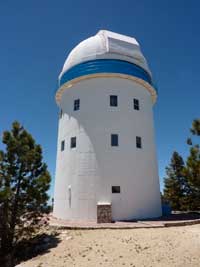High above two coastlines, Kristian Beadle looks for clues about the climate.
Location: Sierra San Pedro Martir, an alpine national park in the middle of the Baja peninsula, at a campsite surrounded by pine trees and chunks of snow, 8,000 feet above sea level.
Conditions: Cold! The sun just set behind the trees and a chill is setting in. The open-air fire is keeping our feet warm.
Discussion: From the top of the astronomical observatory, we could see the outline of the Sea of Cortez to the east and faint glimmers of the Pacific Ocean to the west.
“It has been a little hazy these last two days,” said Esteban Valdés, the supervisor at the observatory, as if apologizing for the slightly imperfect climatic conditions. They claim to have the second best visibility in the whole world (behind a location in Chile), with clear night skies at least 80 percent of the year.

I had come searching for climate data taken at the observatory — but I was out of luck, it was not available. Instead we got a tour of the 2.1-meter telescope, which is an impressive piece of glass, but will just be the little brother of the new 6.5-meter telescope being planned on site thanks to co-investments from the French and Chinese.
Across the valley lies another kind of observatory: the Picacho del Diablo, (Devil’s Peak) the highest point in Baja California, sheer granite slabs rising to a bit over 10,000 feet. Its dramatic shape rises out of the pancake-flat desert to the east and seems to erode into a pine-covered pattern of ridges heading toward the west.
The Sierra San Pedro Martir is supposedly one of the least visited national parks in the country. It is similar to national parks in the U.S., but slightly … quirky, like a teenager that feels awkward in the company of others. Does the park prefer to be alone and sulk in its self-conservation, or does it want company to share its natural wonders? It is still growing up, with a number of signs telling people what to do/not to do but no signs telling us where to go.
Alyssum and I walked through the ponderosa pine forest, following a creek past scattered aspen meadows. The alpine atmosphere was refreshing after the dusty coastline, but there was still something … somber about it. Perhaps it was the lack of animals or the endless rhythm of pine trees? I wondered if there was more beneath the surface than I could see.
Thoughts whizzed in my mind from other places: Bark beetles had killed pine forests in New Mexico, some say due to warming temperatures (keeping larvae alive longer), drought or even fire suppression. Early melting of the snowpack in California’s Sierra Nevada, caused by higher annual temperatures, is starting to affect the state’s water supply (snow normally melts later in the year, providing water for the dry summer and autumn months). Were any of these lessons applicable here?

In this forest of Baja, high above the two coastlines below, I looked for clues about the climate. The trees were silent, and there was nobody to ask about bark beetles or water supply. Then a bright blue jay chirped to break the silence and flew away with tremendous speed. The creek gurgled and wind started whizzing in various pitches through the trees, like the sounds of approach and departure. Or, if you like, past and future. What will this place be like in 1,000 years? It is not such a long period of time, after all — just 10 people living 100 years.
Even bigger than the astronomical telescopes, and the summit of Picacho del Diablo, this, I realized, is the biggest observatory of all. I let it rest at that.





